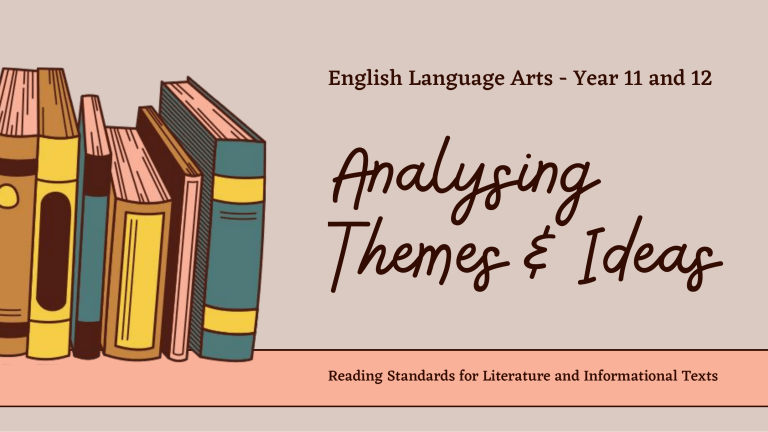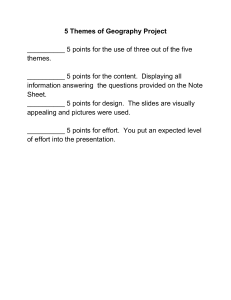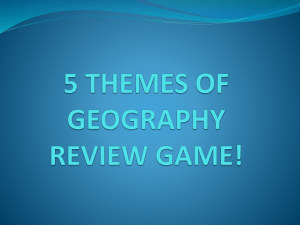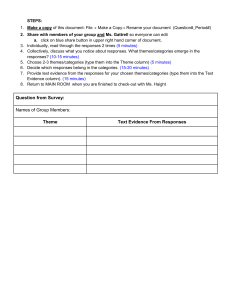English Analysing Themes and Ideas Presentation Beige Pink Lined Style
advertisement

English Language Arts - Year 11 and 12 Reading Standards for Literature and Informational Texts The following presentation and collection of resources will focus on students developing the skills to achieve the following: 1 2 3 4 Provide an objective summary of a text Determine two or more themes or central ideas of a text Analyze the development of themes or ideas over the course of the text Cite strong and thorough textual evidence to support their analysis When we read and analyse texts in English class, often you'll be asked to identify their themes or central ideas. Although we might start with one word topics, in upper school, the expectation is that students should be able to identify, specifically, what the text is saying about the topic. That is, they should be able to state themes as explicit ideas. In literature, this can be a moral or message or it might just be a comment on, or an exploration of, a particular human experience. In an informational text, central ideas might the the authors argument or comment on a topic or it might be a more general exploration of an event, person or issue. Through themes, writers can communicate their thoughts about things they find interesting or concerning about people, society or the world. Texts can have multiple themes or ideas, some more dominant than others, so it's important to be able to identify these as well as consider how they develop throughout the course of the text. Before we delve into themes and ideas, it's important to understand the difference between summarising a text and analysing a text. Summary The "what" of the text. A summary is usually a short description that restates the topic or content of the text. It is used to give the reader an overview of what the story or article is about. It provides a brief account of what is covered in the text (main points only) and is written in a short, clear and concise way, without delving into specific examples. Analysis The "how" of the text. An analysis is a more detailed and in depth exploration of the text. It aims to deconstruct a text by examining its parts and commenting on how they work together to achieve a purpose. The writer evaluates, examines and interprets the content, drawing their own conclusions and providing specific examples to illustrate their points. As previously mentioned, the easiest way to start identifying themes and ideas is to ask: What is the text about? What topics or issues does it explore? We might begin by writing down singular words or short phrases e.g. war, growing up, homelessness, bravery or environmentalism. Then, we need to turn these into statements - that is, we write them as a series of specific ideas rather than as a single word. Start with a keyword to help you build a phrase. Your statement should not identify any examples from the text (i.e. specific characters/people, settings/places, or plot features/events) but rather focus on the broader idea about people, society or the world that the text conveys. To be successful, you should be able to use the phrase "The text conveys the idea that..." before your theme statement to form a complete sentence. Here are some examples of themes that have been turned into specific ideas. Coming of Age The journey from innocence to experience often involves changing ideas about oneself and one’s place in the world. Family An irrational commitment to biological and familial ties can be destructive on an individual. Identify Our identify is not fixed but fluid; it can shift and change depending on different circumstances. Prejudice Racism and prejudice are limitations to progress, both to the individual and society as a whole. It is rare for a text to centre around one theme or idea; often there are multiple. Some might be more dominant or obvious than others. These themes and ideas might interact and/or rely on one another in order to form a complex story or investigation. For example, a coming of age narrative novel for an adolescent audience might explore themes of bravery, family relationships, friendship, coping with change and maturity. An informational feature article for an audience of parents on the topic of standardised testing might explore ideas about education, student stress, academic success and differences in individual abilities and learning needs. It's also important to note that different readers can read the same text and identify different themes or ideas due to their personal context. These ideas may not always be deliberately intended by an author, but a reader might interpret them based on their personal reading of the text. Considering the fact that themes and ideas can be quite complex, it's important to consider how they develop throughout a text. Beginning Middle End How does the author introduce the theme or idea? What comments are made about the theme early on in the text? Consider the opening paragraphs of an article or the opening chapters of a novel. How are the themes or ideas developed further through the body of the text? Do they stay the same or evolve? Consider the use of narrative elements in literature or evidence provided in informational texts. How do the themes or ideas conclude at the end of the text? Is there a final stance taken or is it left open ended? Consider if there's a moral or message to a literary text or if an informational text has a balanced or one sided argument. Another important thing to consider is that although some texts can state themes or ideas explicitly (such as an author of an informational text stating their argument or a character in a literary text directly stating an idea directly through dialogue), many texts infer these themes more subtly and it is up to you to draw inferences based on what is available. To clarify, an inference is a conclusion reached based off evidence and reasoning. This requires you to 'read between the lines' to extract a theme or idea based on the textual elements or information available to you. This might take the form of conclusions, predictions, critical judgements or interpretations. As humans, we do this naturally every day but the study of texts in English is an active and reflective process whereby you not only need to identify the ideas but consider how you came to reach them. You might compare this to mathematics where you are not only required to calculate a correct answer but you also must 'show your working out' in order to achieve full marks. English is no different. The final step after identifying your themes or ideas is to cite strong and thorough textual evidence to support your analysis. This requires you to identify specific examples or elements of the text that have influenced your interpretation of these ideas. Remember, in upper school we avoid paraphrasing examples as this can be too general. Instead, we look for explicit evidence such as direct quotations from the text to illustrate our analysis. We should also go a step further and comment on the textual conventions, language features, structural features or stylistic choices that are shown through each specific quotation. These will differ depending on whether the text you are discussing is literary or informational. Literary Texts The textual evidence you provide might include: • examples of narrative conventions such as characterisation, setting, point of view, plot events or symbolism • language features such as descriptive language, figurative language, lexicon and connotation • structural features such as flash back, foreshadowing, prologue or epilogue Informational Texts The textual evidence you provide might include: • evidence supplied by the author including facts, statistics, expert opinion, personal anecdotes or case studies • language features such as rhetorical question, inclusive language, repetition or hyperbole • structural features such as cause and effect, problem-solution, compare and contrast In this course, we will be reading, summarising and analysing a range of literary and informational texts. Identifying multiple themes or ideas and analysing their development over the course of a text is a central skill that we will need to achieve success in the course. You will also need to be able to cite strong and thorough textual evidence to support the text's explicit ideas as well as your own inferences drawn from the text. Now, let's put these skills into practice by completing some analysis activities. Good luck!




